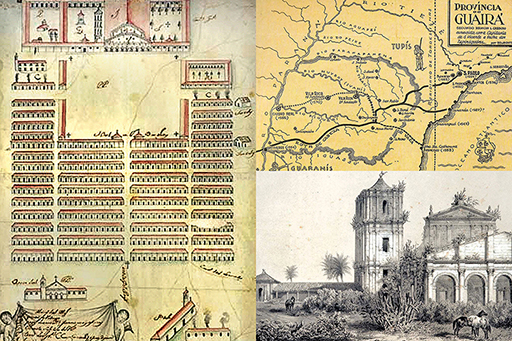

he intention to “reduce”, or gather into villages the indigenous peoples who inhabited the lands conquered by Spain, in the region called Guairá Province, became policy in 1608, when the Governor of Paraguay, Hernando Arias de Saavedra (“Hernandárias”), asked the Spanish king to send Jesuits to convert the natives to Catholicism.
After they founded Reductions at Loreto and Santo Inácio in 1610, on the left bank about halfway along the course of the Paranapanema River, the Jesuits established eleven more Reductions in the area. Four of them were set at different places along the banks of the Tibagi River, or nearby. Lined up, with the river as the common means of communication between them, the Reductions seemed to be a barrier against possible invaders and Indian hunters. The priests justified “reducing”the natives in villages by claiming that it defended them from the Spanish “encomendeiros” who used them for slave labor in the fields of Serra de Maracaju, in Paraguay, where yerba mate was grown and extracted.
In 1622, the São Francisco Xavier Reduction was founded, in what is now the Ibiporã municipality. In 1625, the São José Reduction was founded at the source of a small affluent on the left bank of the Tibagi, probably between the Ibiporã and Sertanópolis municipalities. The Nossa Senhora da Encarnação (or Encarnación) Reduction was founded a little below the mouth of the Barra Grande River, also in 1625. The São Miguel Reduction, founded in 1627, was on the left bank of the Cavernas River, a little above its confluence with the Tibagi, in the Paranaense municipality of the same name.
Formed in a short period of time, the Reductions did not last long. Their brief existence left nothing to locate them precisely, at least up till now.
In 1628, a large Paulista bandeira commanded by Antonio Raposo Tavares left São Paulo in the direction of Guairá. The bandeira was made of 900 whites and 3,000 natives, and was divided into four sections.They stopped in front of the Encarnación Reduction and built a solid pallisade, which over the next four years served as a base for the capture of natives who lived in the areas outside the Jesuit villages. However, in the beginning 1629, the bandeirantes violently attacked the Santo Antonio and Jesus Maria Reductions, and finally the Miguel Reduction. They forcibly removed thousands of natives and took them to São Paulo. The implacable actions of the Paulistas caused the Jesuit priests to leave Guairá for the Tape region, in the center of what is now the State of Rio Grande do Sul, where they continued their mission.
click on picture
to enlarge